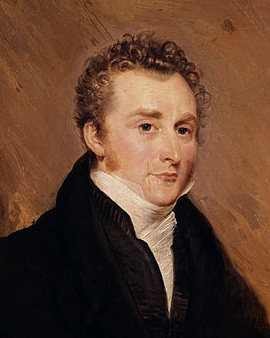Melodramatic scenes of apocalyptic events, biblical and fantastical themes characterize the works of John Martin, an English engraver, illustrator and artist of the nineteenth century. He was a devout Christian, but defended deism and was a follower of natural religion. Works like "The Last Judgement", "The Great Day of His Wrath" and "The Heavenly Planes" reflect the artist's personality. His works are characterized by small figures in wide architectural and landscape settings, perfected by dramatic lighting, imagination and attention to detail. Above all, the motif of the landscape, in which he was largely inspired by the nature of Northumberland, made him a great representative of Romanticism. His dark, oppressive but at the same time stirring character made him stand out from his competitors.
With his master, the Italian artist Bonifacio Musso, he moved to London where he married at the age of nineteen. Apart from selling his paintings, John Martin also earned his money through drawing lessons and glass and porcelain painting. From 1812 onwards, he received greater attention for his works; however, the public only really became aware of him when his brother Jonathan Martin, also known as "Mad Martin", set a fire in the York Minister. Although he met with public enthusiasm, his wish - to become a member of the Royal Academy - remained unfulfilled, as critics like John Ruskin described his work as vulgar.
Instead, he joined the Society of British Artists from 1824 to 1838. He also became the official history painter of Prince Leopold of Saxe-Coburg and was awarded the Leopold Order for his paintings. Besides painting, John Martin had a keen interest in architecture, which is why he was involved in drawing up plans for London's water supply, sewerage and railway systems.
Although the artist lost more and more prestige, he left his mark even after his death in 1854: his works encouraged the American artist Thomas Cole in particular to found the Hudson River School. He also inspired the Pre-Raphaelites, especially the British painter and poet Dante Gabriel Charles Rossetti. Some of Martin's paintings, for example "The Destruction of Sodom and Gomorrah", "Clytie" and "The Bard", can now be seen in the Laing Art Gallery in Newcastle.
×





.jpg)
.jpg)
.jpg)
.jpg)
.jpg)
.jpg)
.jpg)
.jpg)
.jpg)
.jpg)
_-_(MeisterDrucke-644528).jpg)
_-_(MeisterDrucke-644528).jpg)
_published_by_Th_-_(MeisterDrucke-189256).jpg)
_published_by_Th_-_(MeisterDrucke-189256).jpg)
.jpg)
.jpg)
.jpg)
.jpg)
.jpg)
.jpg)
.jpg)
.jpg)
.jpg)
.jpg)
.jpg)
.jpg)
_-_(MeisterDrucke-644501).jpg)
_-_(MeisterDrucke-644501).jpg)
.jpg)
.jpg)
.jpg)
.jpg)
.jpg)
.jpg)
.jpg)
.jpg)
.jpg)
.jpg)
.jpg)
.jpg)
.jpg)
.jpg)
 - (MeisterDrucke-644525).jpg)
 - (MeisterDrucke-644525).jpg)
.jpg)
.jpg)
.jpg)
.jpg)
_-_(MeisterDrucke-314800).jpg)
_-_(MeisterDrucke-314800).jpg)
.jpg)
.jpg)
 - (MeisterDrucke-282641).jpg)
 - (MeisterDrucke-282641).jpg)
.jpg)
.jpg)
.jpg)
.jpg)
.jpg)
.jpg)
 - (MeisterDrucke-62112).jpg)
 - (MeisterDrucke-62112).jpg)
.jpg)
.jpg)
.jpg)
.jpg)
.jpg)
.jpg)
.jpg)
.jpg)
.jpg)
.jpg)
.jpg)
.jpg)
.jpg)
.jpg)
.jpg)
.jpg)
.jpg)
.jpg)
.jpg)
.jpg)
.jpg)
.jpg)
.jpg)
.jpg)
_-_(MeisterDrucke-571785).jpg)
_-_(MeisterDrucke-571785).jpg)
.jpg)
.jpg)
.jpg)
.jpg)
.jpg)
.jpg)
.jpg)
.jpg)
.jpg)
.jpg)
.jpg)
.jpg)
.jpg)
.jpg)
_1840_-_(MeisterDrucke-645111).jpg)
_1840_-_(MeisterDrucke-645111).jpg)
.jpg)
.jpg)
.jpg)
.jpg)
.jpg)
.jpg)
.jpg)
.jpg)
.jpg)
.jpg)
.jpg)
.jpg)
.jpg)
.jpg)
_-_(MeisterDrucke-644496).jpg)
_-_(MeisterDrucke-644496).jpg)
.jpg)
.jpg)
.jpg)
.jpg)
 pub - (MeisterDrucke-228085).jpg)
 pub - (MeisterDrucke-228085).jpg)
.jpg)
.jpg)
.jpg)
.jpg)
.jpg)
.jpg)
.jpg)
.jpg)
_-_(MeisterDrucke-1496799).jpg)
_-_(MeisterDrucke-1496799).jpg)
 - (MeisterDrucke-644504).jpg)
 - (MeisterDrucke-644504).jpg)
.jpg)
.jpg)
.jpg)
.jpg)
.jpg)
.jpg)
.jpg)
.jpg)
.jpg)
.jpg)
.jpg)
.jpg)
.jpg)
.jpg)
.jpg)
.jpg)
.jpg)
.jpg)
 - (MeisterDrucke-105493).jpg)
 - (MeisterDrucke-105493).jpg)
_-_(MeisterDrucke-644529).jpg)
_-_(MeisterDrucke-644529).jpg)
.jpg)
.jpg)
.jpg)
.jpg)
.jpg)
.jpg)
_-_(MeisterDrucke-1426353).jpg)
_-_(MeisterDrucke-1426353).jpg)
.jpg)
.jpg)
.jpg)
.jpg)
.jpg)
.jpg)
.jpg)
.jpg)
.jpg)
.jpg)
Illust_-_(MeisterDrucke-1381237).jpg)
Illust_-_(MeisterDrucke-1381237).jpg)
.jpg)
.jpg)
_-_(MeisterDrucke-1432406).jpg)
_-_(MeisterDrucke-1432406).jpg)
 - (MeisterDrucke-242251).jpg)
 - (MeisterDrucke-242251).jpg)
.jpg)
.jpg)
_-_(MeisterDrucke-644495).jpg)
_-_(MeisterDrucke-644495).jpg)
.jpg)
.jpg)
.jpg)
.jpg)
_-_(MeisterDrucke-591612).jpg)
_-_(MeisterDrucke-591612).jpg)
.jpg)
.jpg)
 - (MeisterDrucke-644530).jpg)
 - (MeisterDrucke-644530).jpg)






